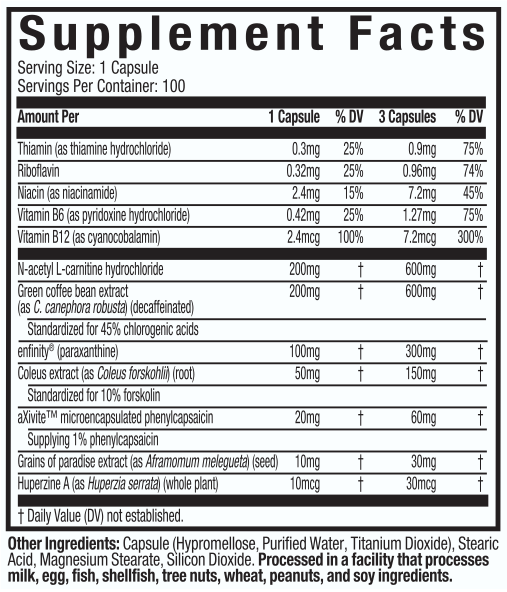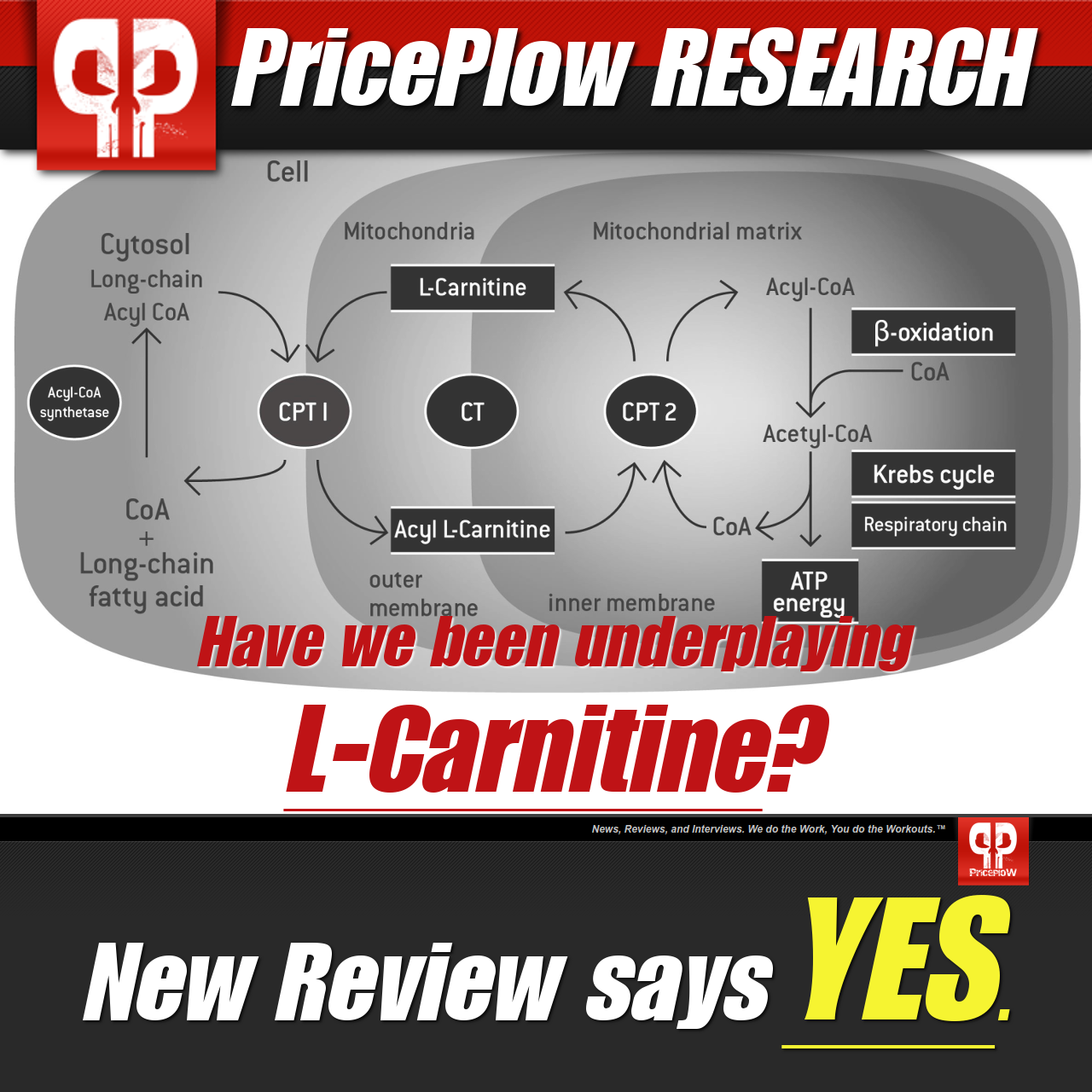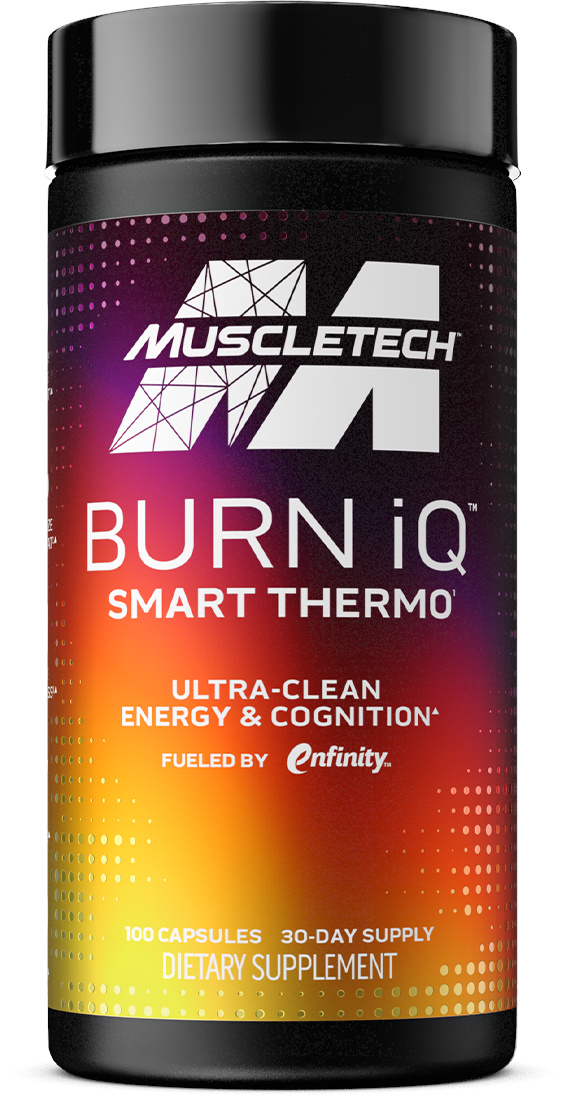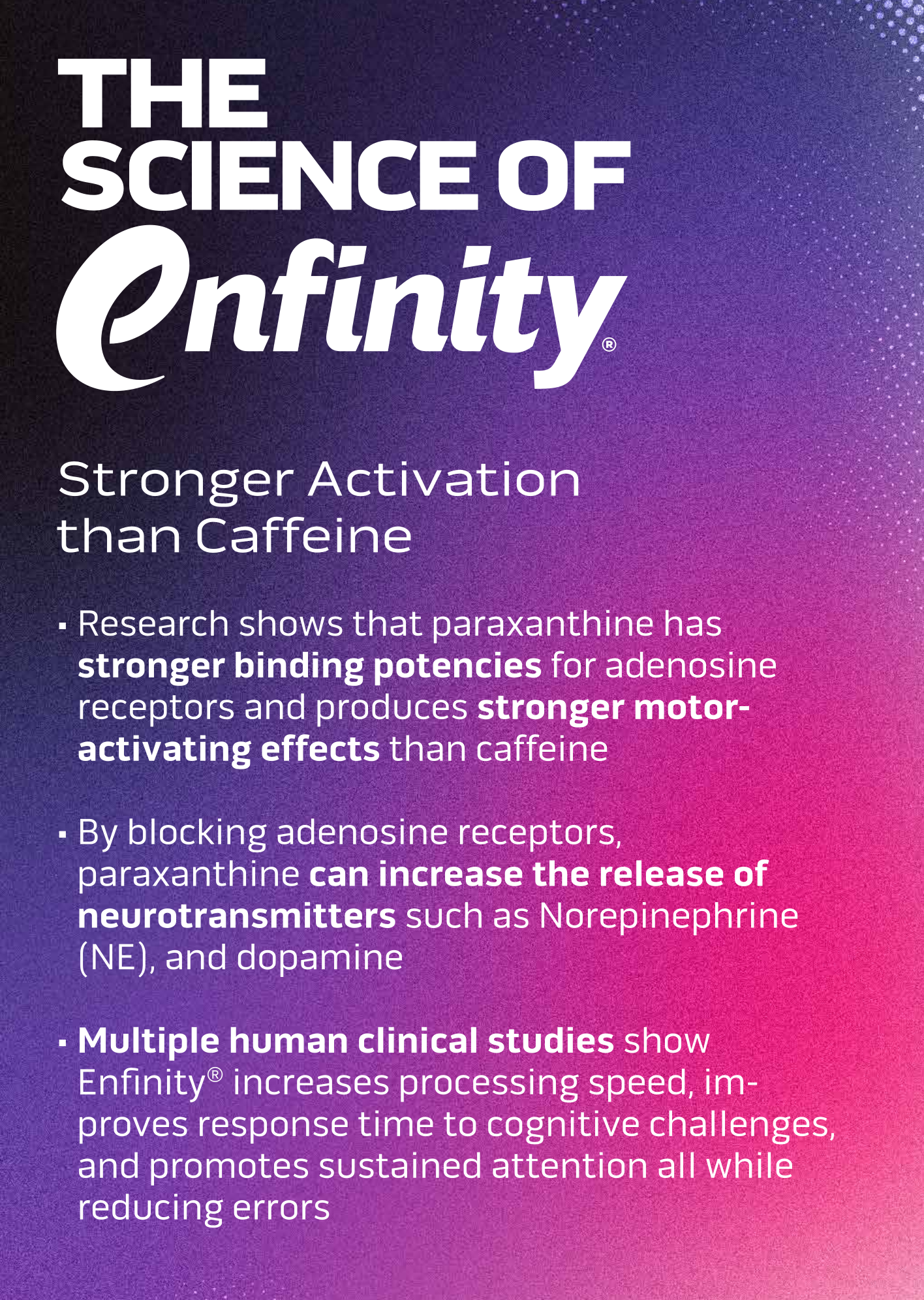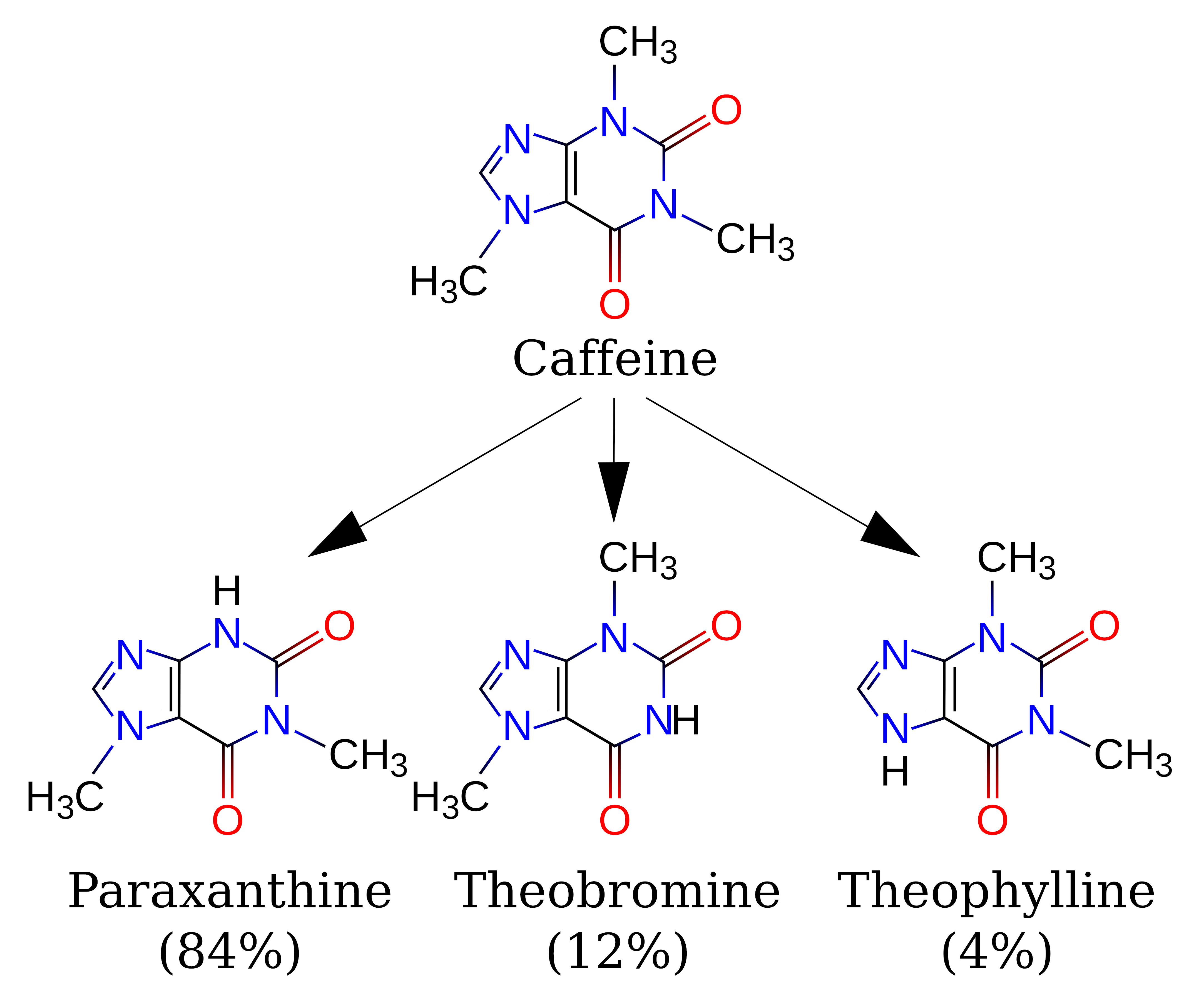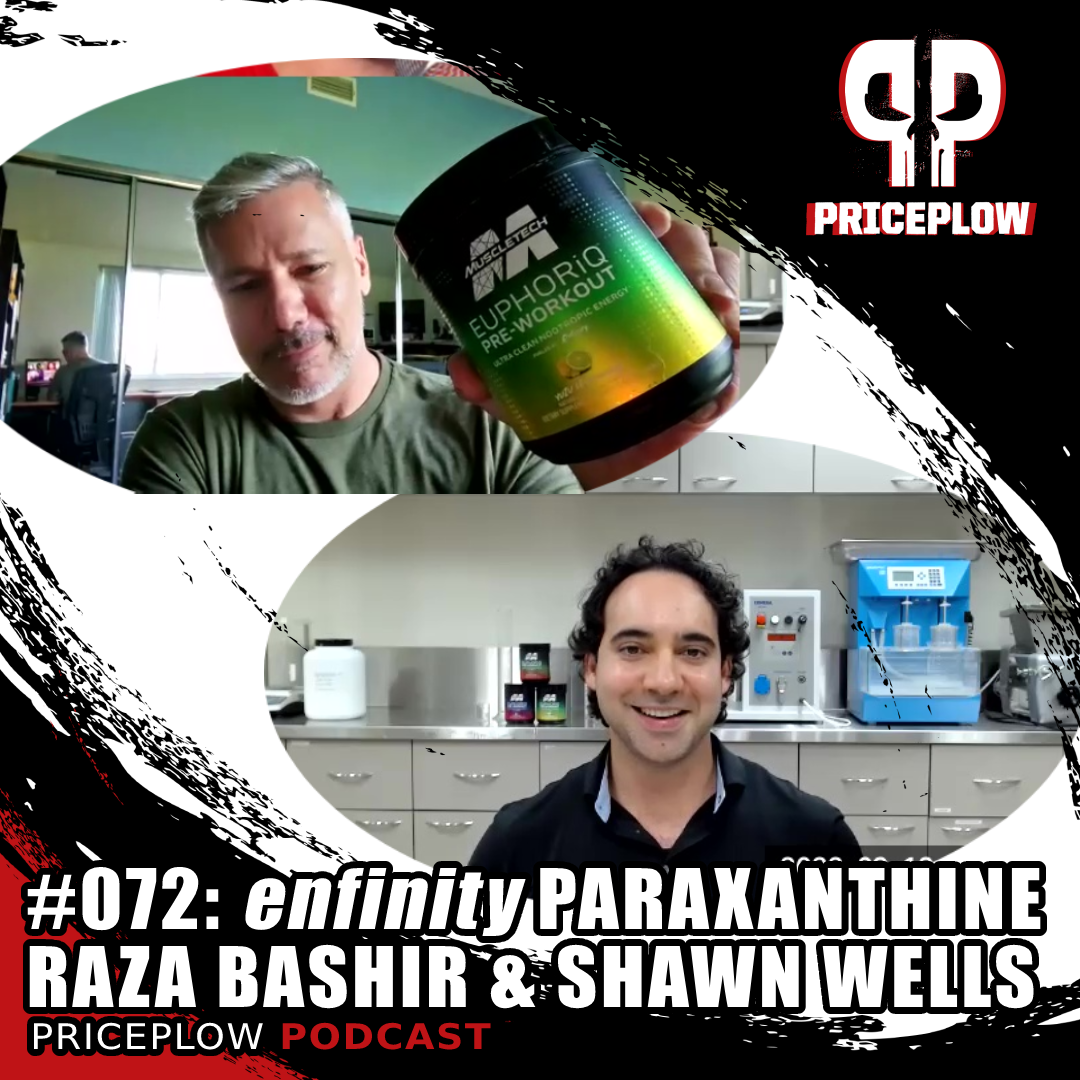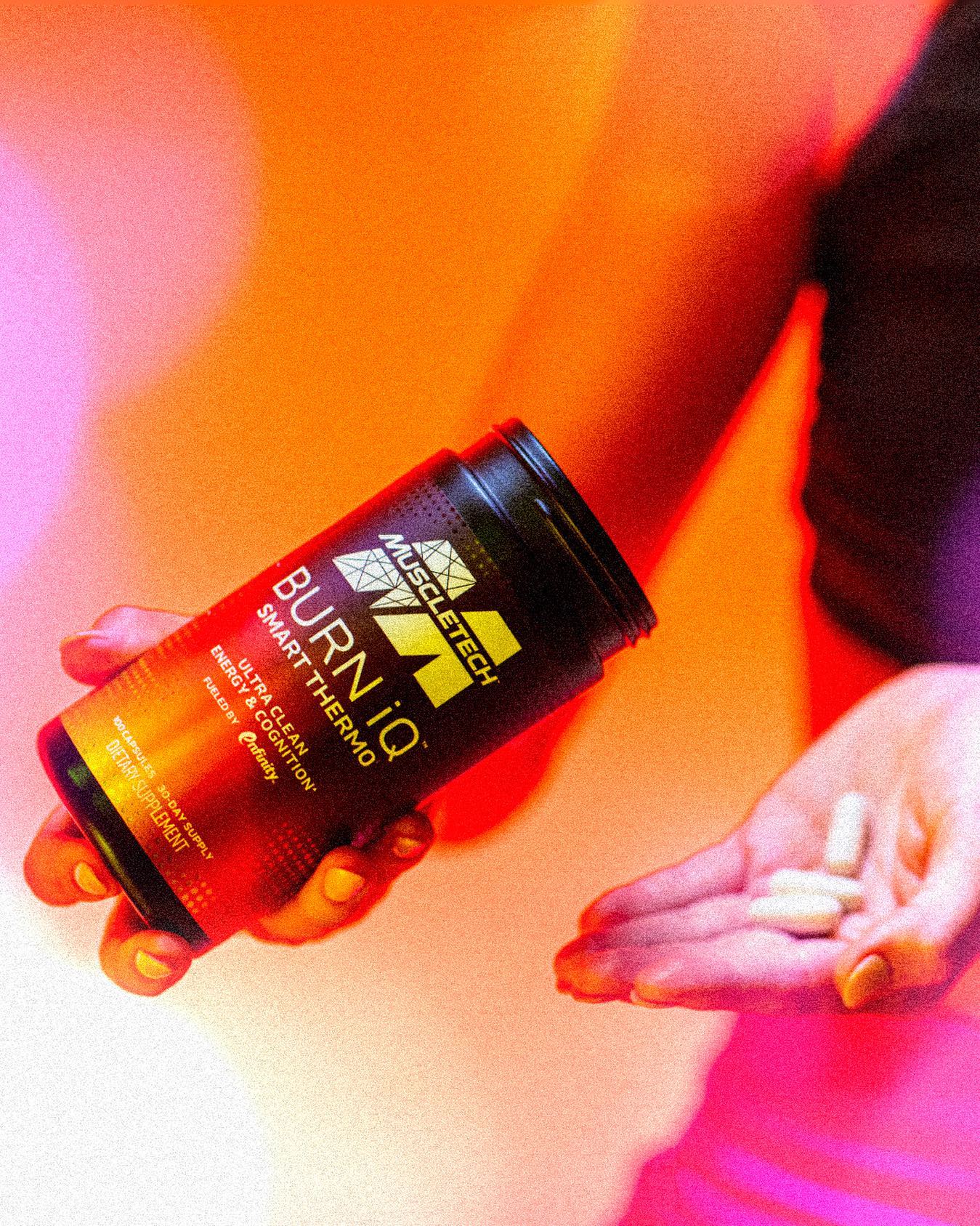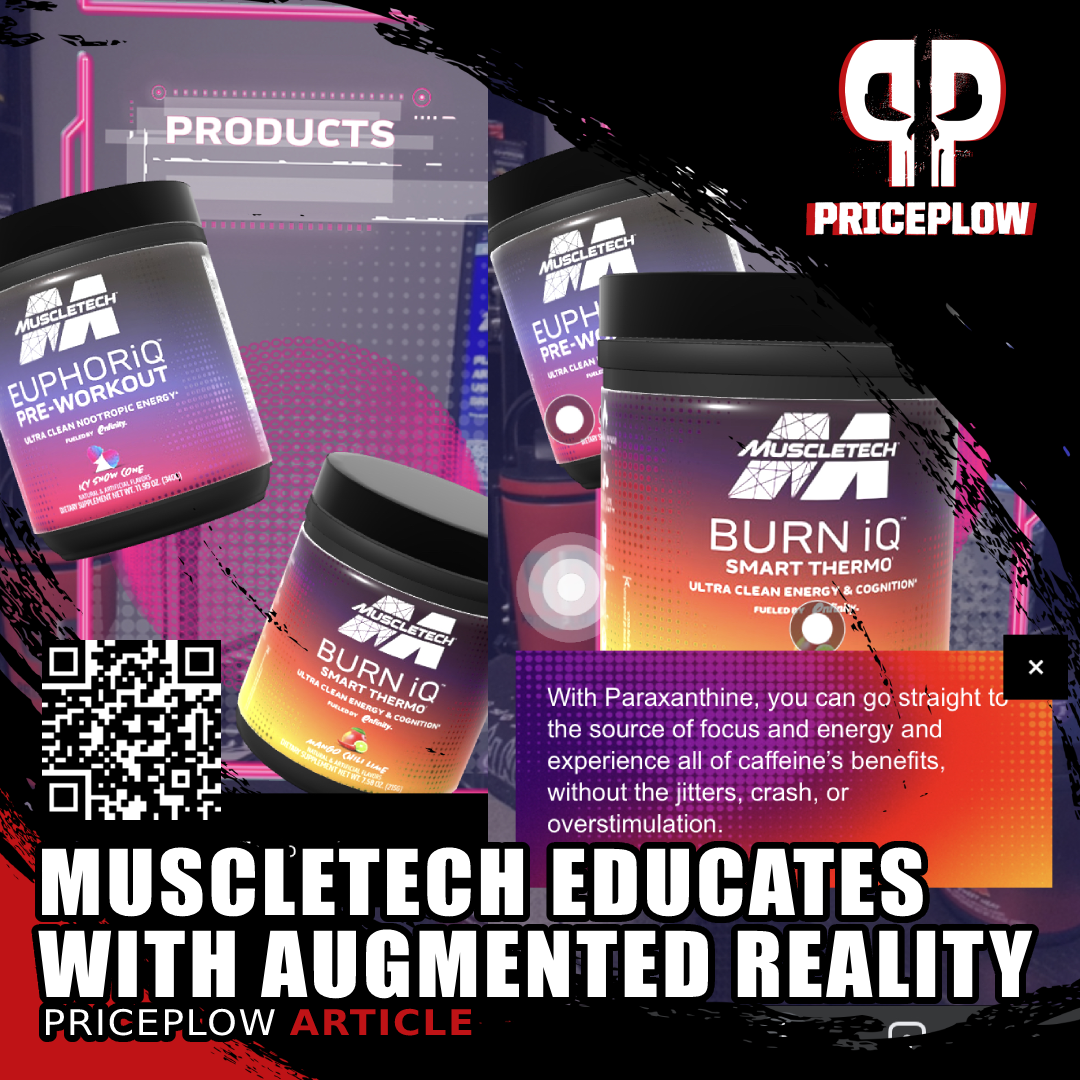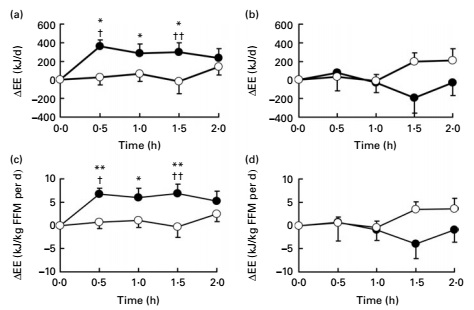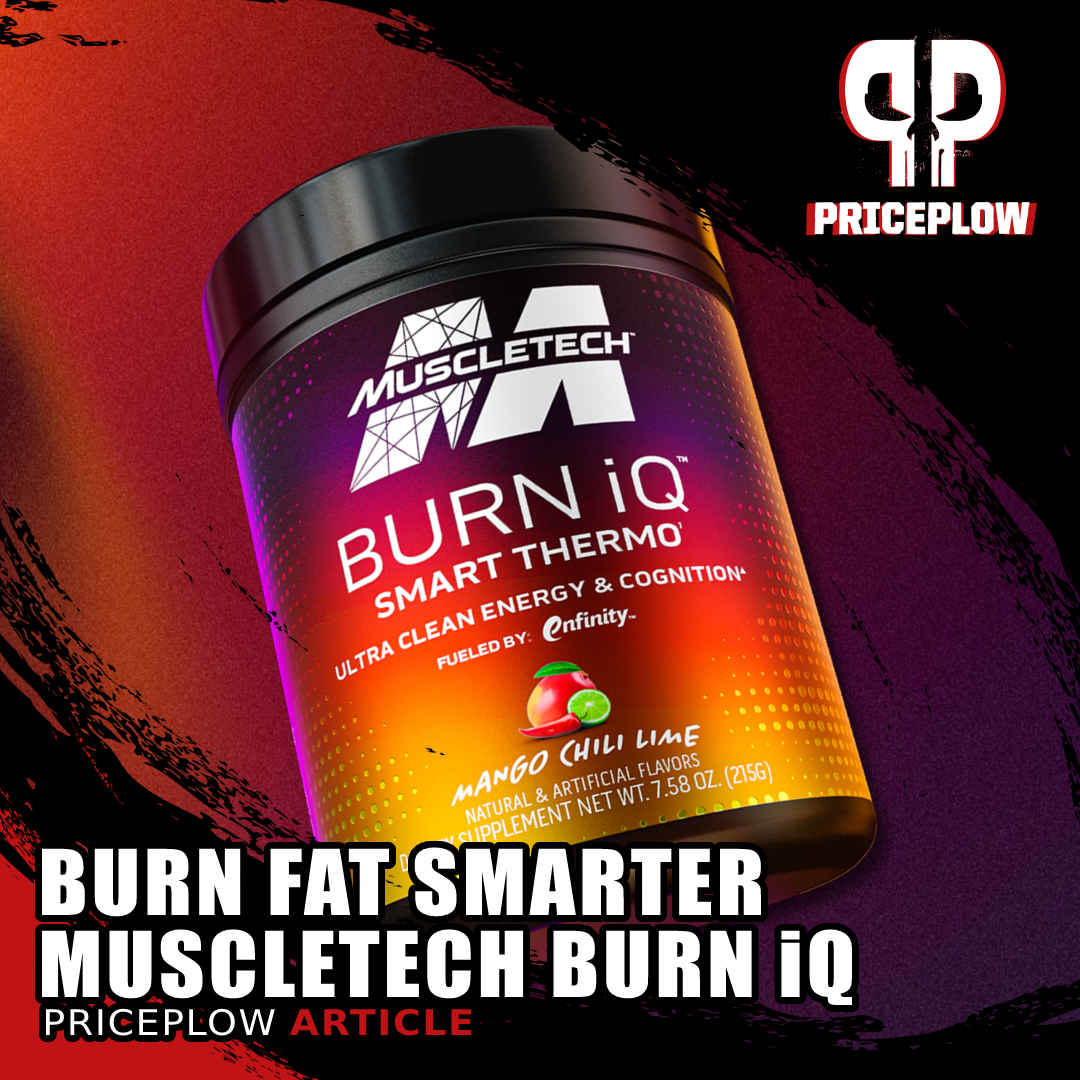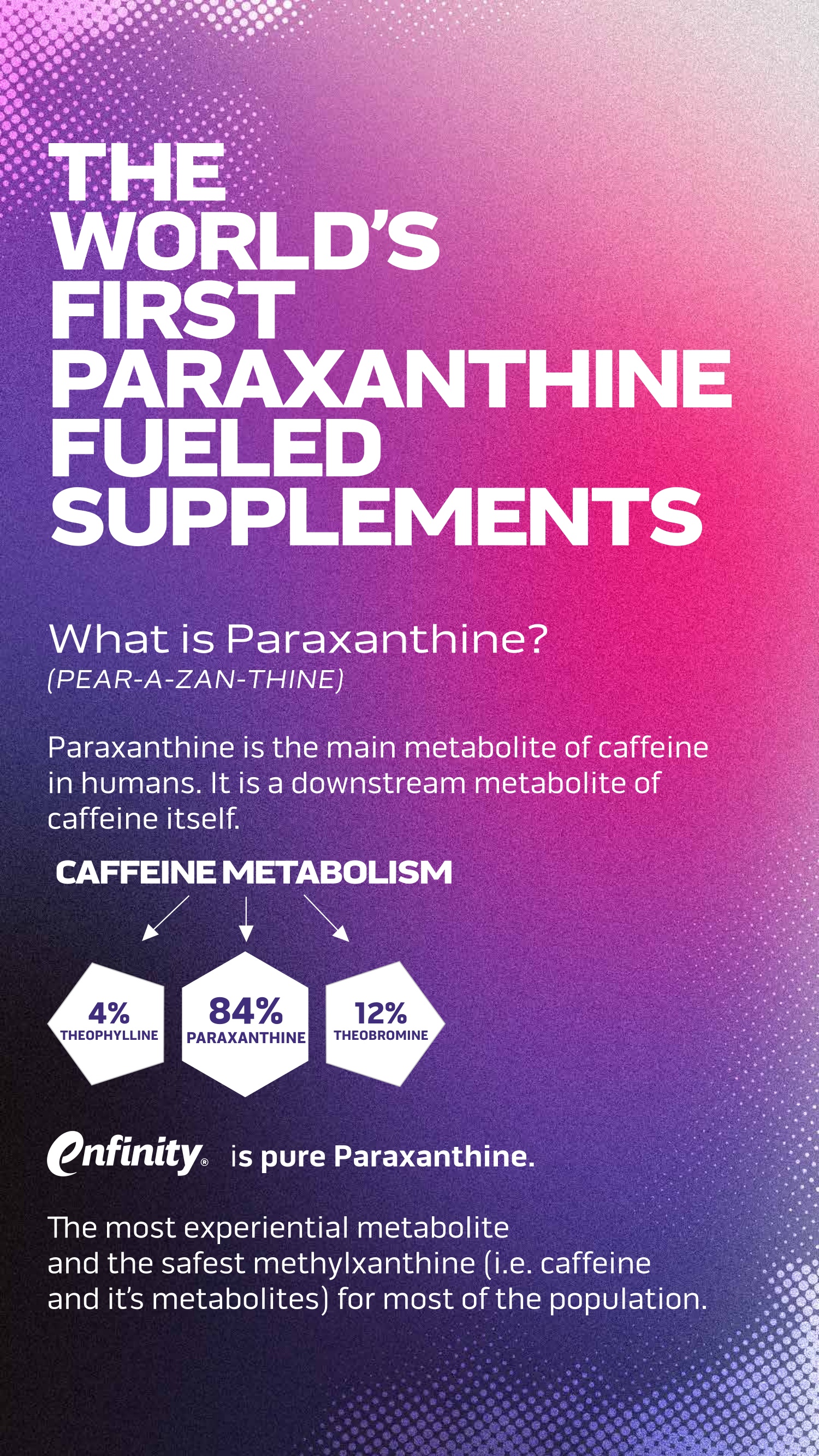All the entries in MuscleTech's new iQ Series of nootropic supplements have one really compelling thing in common: they all use enfinity brand paraxanthine instead of caffeine. This, as we'll see later on in the article, is a huge value proposition, and MuscleTech is currently the industry leader on paraxanthine use.
We've previously written about MuscleTech's use of paraxanthine in our previous articles MuscleTech EuphoriQ: The Smart Pre-Workout with enfinity Paraxanthine and MuscleTech Burn iQ Thermo Powder: The Smarter Way to Burn Fat.
But we're posting this around New Year's, so you know what that means -- it's diet time:
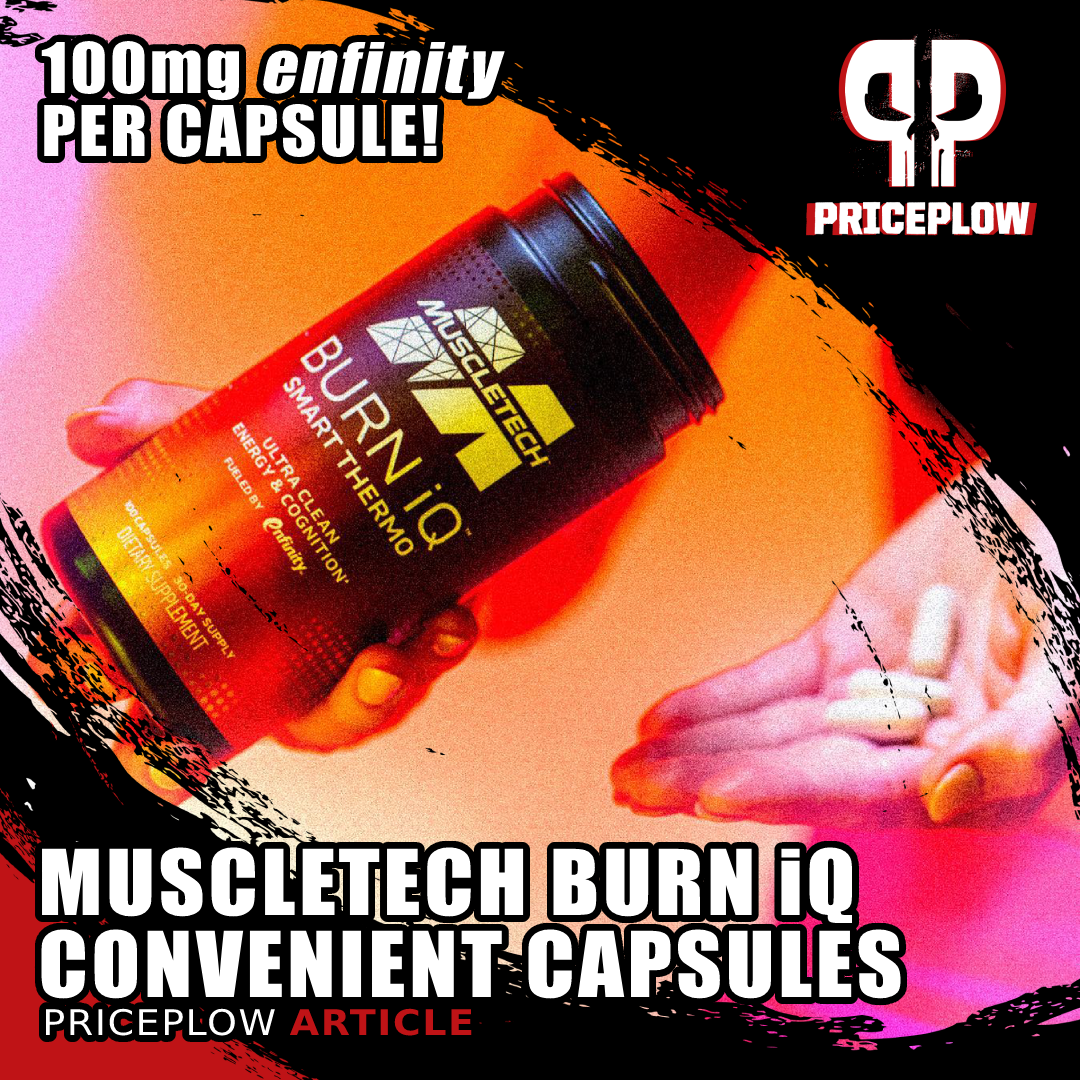
The new year brings a new time to try a new fat burning supplement - and MuscleTech's Burn iQ includes a new caffeine replacement in enfinity brand paraxanthine!
MuscleTech Burn iQ: Available in Capsule Form!
Today we're going to discuss MuscleTech's capsule form of Burn iQ. Compared to the powder form that we've previously reviewed, there are some minor formula changes for the sake of saving space. For instance, there's no taurine in this version, and carnitine has been switched to the acetyl form (which we love) but with a lesser dose to fit it all into capsules.
But you can't beat the convenience of a capsule-based supplement, and fortunately, we've got just as much paraxanthine here as in the powder form when comparing a full serving of each.
For those of you who didn't read our first Burn iQ write-up, the idea behind this supplement is to burn more fat and help improve cognitive function.
This is MuscleTech's mission to get you to supplement smarter, after all. The reason is that strict dieting usually takes a toll on people's mental energy levels, and nootropic ingredients are a great non-caloric way to help ameliorate this.
Let's check on PricePlow's coupon-powered prices and get into the ingredients:
MuscleTech Burn iQ – Deals and Price Drop Alerts
Get Price Alerts
No spam, no scams.
Disclosure: PricePlow relies on pricing from stores with which we have a business relationship. We work hard to keep pricing current, but you may find a better offer.
Posts are sponsored in part by the retailers and/or brands listed on this page.
This area is reserved for Team PricePlow's upcoming videos.
Subscribe to our channel and sign up for notifications so you catch it when it goes live!
MuscleTech Burn iQ Capsule Ingredients
In a single 3 capsule serving of Burn iQ from MuscleTech, you get the following:
-
N-acetyl L-carnitine hydrochloride – 600 mg
With 100 milligrams of paraxanthine per capsule, you can dose your Burn iQ Capsules pretty flexibly!
Carnitine is a quaternary ammonium compound that helps your cells burn fat for energy. It does this by moving fatty acid molecules into your cells, where your cellular mitochondria can take them up and turn them into adenosine triphosphate (ATP).[1]
Carnitine has been shown to upregulate specific enzymes that your mitochondria use for ATP synthesis.[2,3] Partly because of this, carnitine can help stabilize mitochondria, preserving or
even improving their function in the face of metabolic stress.[4]
That's because ATP is the form of energy that your body actually consumes to do work – if your body were an engine, ATP would be the gasoline. Increasing ATP production generally reflects a corresponding increase in metabolic rate.
As a matter of fact, carnitine doesn't just increase your cells' rate of fat burning – it's actually necessary for fat burning to occur.[5] That's why testing for carnitine deficiency is one of scientists' chief methods for identifying children with certain metabolic disorders.[6]
After reading a new review article based upon 100 citations, we are finding fewer and fewer reasons not to take carnitine
If it gets bad enough, it can even turn into primary carnitine deficiency,[7] a condition in which systemic carnitine deficiency renders the body unable to burn fat for fuel. That should give you some idea of how crucial carnitine is for human health.
That's why we want to make sure we get enough carnitine from food or supplements. Plenty of research has demonstrated that carnitine supplements can cause healthy fat loss,[8,9] while also increasing insulin sensitivity and supporting glucose metabolism.[10]
You've probably heard about brown adipose tissue (BAT) or "brown fat," a type of body fat tissue that is responsible for a great deal of your body's metabolic activity. Brown fat is the type of fat upregulated by cold exposure, for instance.
If so, you'll probably be interested to hear that carnitine is required for your body to create and maintain BAT.[11]
-
Green coffee bean extract (as C. canephora robusta) (decaffeinated) Standardized for 45% chlorogenic acids – 600 mg
Green coffee bean extract (GCE) is derived from green coffee,[12] the name for raw, unroasted coffee beans. GCE is usually standardized for chlorogenic acid, a polyphenol antioxidant with known anti-inflammatory, anti-obesity, anti-diabetic, anti-carcinogenic, and antioxidant properties.[12] GCA has been shown to increase the human body's metabolism of both fatty acids and glucose.[13]
According to one study published by the journal Gastroenterology Research and Practice, GCE can actually inhibit your body's absorption of glucose, while removing fat from your liver tissue. What's more, it can prevent your body from forming new fat cells and cholesterol molecules, while increasing the rate at which your body metabolizes existing body fat and cholesterol.[12]
Another study, published in Phytotherapy Research, found that CGA can help liberate fatty acids from stored body fat, which enables your body to burn them as fuel. This takes place even when GCE is not administered with caffeine,[13] which is an important point considering that we have a decaffeinated form of GCE in MuscleTech's Burn iQ capsules.
Regarding this decaffeinated green coffee bean extract, remember that this is a caffeine-free supplement that's instead using paraxanthine, caffeine's metabolite. So let's discuss that next:
-
enfinity (paraxanthine) – 300 mg
Now we have a cutting-edge ingredient whose use has really been pioneered by MuscleTech – enfinity paraxanthine, at 100 milligrams per capsule. Two feels good, three feels great!
Paraxanthine is a methylxanthine alkaloid, just like caffeine. But it's actually a caffeine metabolite. In fact, it's the primary caffeine metabolite: every time you ingest caffeine, your body converts most of that caffeine into paraxanthine.
What's cool about paraxanthine is that it gives us the upsides of caffeine, without the downsides.
Paraxanthine vs. caffeine – similar, but better
A brief intro to the science of paraxanthine / enfinity. We'll cover far more data as it's published!
That sounds too good to be true, right? Well, let's take a look at what the research has to say. So far it indicates that paraxanthine can, just like caffeine, increase your body's rate of fat burning[14] by inhibiting phosphodiesterase[15] and upregulating cyclic adenosine monophosphate (cAMP).[16] It's important to emphasize that these are the same mechanisms of action behind the fat-burning action of caffeine itself.[17,18]
Paraxanthine also, like caffeine, can help fight fatigue by antagonizing adenosine receptor function[19] and upregulating dopaminergic activity,[20] which can also benefit motivation and focus.
In fact, when it comes to mental benefits, paraxanthine might be even better than caffeine. Head-to-head comparisons between caffeine and paraxanthine have found that paraxanthine is actually better at inhibiting the action of adenosine, improving psychomotor skills, and improving cognitive performance than caffeine![21,22]
Paraxanthine also seems to be better at supporting muscle growth than caffeine![23]
Why paraxanthine over caffeine?
In addition to paraxanthine's heightened ability to improve mental and physical performance, it also comes with some important metabolic advantages over caffeine.
Caffeine has three major metabolites, and one of them (paraxanthine) does the heavy lifting. The other two have very long half-lives, which could be interfering with your quality of energy! Image courtesy Wikimedia
The main thing to consider here is that paraxanthine has a much shorter half-life than caffeine – 3.1 hours vs. 4.1 hours![24]
But perhaps even more importantly, taking paraxanthine instead of caffeine spares you from dealing with the effects of caffeine's other metabolites: theobromine and theophylline. These two metabolites are, like caffeine and paraxanthine, methylxanthine alkaloids with significant stimulant effects.
Wel, the half-lives of theobromine and theophylline are about 6.2 hours and 7.2 hours, respectively[24] – they stay in your system much longer than caffeine or paraxanthine. By taking paraxanthine instead, you are not exposing yourself to the very long action of these stimulant metabolites.
That means you'll almost certainly have fewer lingering effects. Paraxanthine is much less likely to keep you up at night, for example, than caffeine or its other metabolites.
This really matters for some people, as individual methylxanthine metabolisms vary with genetics. "Slow" metabolizers of caffeine (and other methylxanthines) can benefit enormously from the relatively short half-life of paraxanthine.[25,26]
-
Coleus extract (as Coleus forskohlii) (root) Standardized for 10% forskolin – 150 mg
MuscleTech's Raza Bashir and Ingenious Ingredients (and NNB Nutrition CSO) Shawn Wells join the PricePlow Podcast for Episode #072 to talk about MuscleTech's new iQ Series launch, using enfinity Paraxanthine!
Forskolin is a diterpene molecule that's extracted from Coleus forskohlii, a type of mint. Forskolin, like paraxanthine, can help your body increase cellular energy production by upregulating cyclic adenosine monophosphate, which naturally speeds up fat burning.[27]
One study found that when supplemental forskolin was combined with caloric restriction, the subjects taking forskolin had better body composition, blood lipids, and insulin sensitivity relative to placebo controls.[28]
Forskolin also appears to be a powerful appetite suppressant.[29,30]
The 150 mg dose used here is pretty big, and it helps illustrate the advantage of using capsules over powder – Coleus extracts generally have a pretty strong taste, which naturally limits the amount you can use in a powder. But with capsules, you don't have to worry about that.
-
aXivite microencapsulated phenylcapsaicin (Supplying 1% capsaicin) – 60 mg
Phenylcapsaicin is a synthetic derivative of capsaicin, the primary bioactive constituent of chili peppers and other spicy plants. It's what causes a burning sensation in your mouth when you eat these foods.
The idea behind adding a phenyl group to the capsaicin molecule is to help stabilize it, which should lead to more consistent results than you'd get with ordinary capsaicin. However, this phenyl group should not interfere with the action of the capsaicin.
Phenylcapsaicin research
A randomized, double-blind, placebo-controlled study found that just 0.56 mg of phenylcapsaicin – way below the dose used in Burn iQ capsules – was able to significantly reduce subjects' levels of zonulin, a protein associated with gut permeability.
In other words, the phenylcapsaicin made their guts less leaky.[31]
Moreover, the people taking phenylcapsaicin lost about 2 kg of fat mass during the study period, which translated to a 2 inch reduction in waist circumference![31]
Capsaicin research
Given the close similarity between phenylcapsaicin and capsaicin, we can also learn something about phenylcapsaicin by looking at capsaicin studies.
Capsaicin has been found to improve insulin sensitivity in obese mice, while simultaneously lowering their blood sugar and removing fat tissue from their livers.[32] What's more, capsaicin can also help prevent fat from building up in the liver in the first place,[33] and may even protect the liver from alcohol-induced injury.[34]
So capsaicin is something of a liver health tonic, which is important since fatty liver and liver dysfunction is associated with insulin resistance, glucose intolerance, and diabetes.[35]
Want to learn more, in an interactive way? MuscleTech is using a high-tech Augmented Reality (AR) platform to educate consumers about their new enfinity-fueled iQ series!
Capsaicin has also been shown to downregulate tumor necrosis factor alpha (TNFα), interleukin-6 (IL-6), and monocyte chemoattractant protein-1 (MCP-1), specifically in liver tissue. These inflammatory cytokines can cause serious metabolic problems if they get out of control, so keeping their levels relatively low is usually a good thing.[32]
Even just 6 milligrams of ordinary capsaicin – again, way less powerful than the 60 milligrams of new-and-improved capsaicin we have in Burn iQ – has been shown to produce fat loss.[36]
A key mechanism of action behind capsaicin is its ability to upregulate brown adipose tissue (BAT)[36] something it has in common with carnitine. Just like carnitine, capsaicin can also prevent the growth of new fat cells.[36]
For this reason, animals treated with capsaicin show a higher metabolic rate than ordinary animals.[36]
Phenylcapsaicin safety
The European Commission's panel on Nutrition, Novel Foods and Food Allergens (NDA) has designated phenylcapsaicin as safe under the proposed applications and doses.[37]
-
Grains of paradise extract (as Aframomum melegueta) (seed) – 30 mg
Aframomum melegueta, also known colloquially as grains of paradise, is a pepper plant that's native to western Africa.
Researchers found that the group consuming the Grains of Paradise extract had a significantly greater increase in energy expenditure, due to increased BAT activity, than the group not receiving the GoP extract.[38]
It naturally contains high concentrations of 6-paradol, a spicy-flavored bioactive constituent that upregulates brown adipose tissue (BAT) in the human body. As we've discussed already in this article, BAT is metabolically active, and burns more calories than white adipose tissue, the other type of human body fat.[39]
Increasing your ratio of BAT to WAT can ultimately help you lose weight faster, by increasing your daily caloric expenditure.[38,40]
One study in healthy young men found that a 40 milligrams per day of grains of paradise extract was able to significantly increase the men's metabolic rate as measured in calories.[40]
A study in women found that the women who took grains of paradise extract significantly reduced the level of visceral fat in their bodies by the end of the study period.[38] This is great news, since visceral fat is especially harmful – it's the type of body fat most closely connected to insulin resistance and diabetes.[41]
To give you an idea of how damaging visceral fat can be, and how good it is to clear it, one animal study showed that the surgical removal of visceral fat almost completely reversed age-related metabolic dysfunction in the animals being operated on.[42]
-
Huperzine A (as Huperzia serrata) (whole plant) – 30 mcg
Huperzine A is a sesquiterpene alkaloid that's been shown to interfere with the action of acetylcholinesterase,[43] an enzyme responsible for breaking down the neurotransmitter acetylcholine.
Rather prefer to "drink your energy"? MuscleTech Burn iQ Powder is the other weight loss supplement to include the caffeine replacement known as paraxanthine (from enfinity) and an incredible assortment of thermogenics and metabolism boosters!
Less acetylcholinesterase activity naturally means higher acetylcholine levels, which is good because acetylcholine plays profoundly important roles in human cognition. Acetylcholine is intimately involved in such fundamental cognitive processes as learning, memory, balance, and coordination.[44,45]
It's especially crucial for memory consolidation, your brain's process of turning short-term memories into long-term ones.[46]
Supplemental huperzine A upregulates acetylcholine powerfully enough to be taken as a standalone nootropic drug. It has significant anti-epileptic and neuroprotective effects that seem to be downstream of its anti-inflammatory action.[47]
Huperzine A has also been shown to protect neuronal mitochondria from oxidative stress.[48]
Huperzine A's effects on metabolism
Huperzine A has also been shown to increase insulin sensitivity in neurons.[49] That's promising, since improvements to insulin signaling generally have huge benefits for whole-body metabolic health.
Although studies on huperzine A specifically and whole-body insulin appear to be lacking, it is worth mentioning that animal studies on acetylcholinesterase inhibitors in general have found that acetylcholinesterase inhibition comes with significant anti-diabetic effects, and may actually improve pancreatic health.[50]
At any rate, it's clear that huperzine A can help mitigate some of the cognitive dysfunction caused by being overweight or obese.[49]
So if you already have some weight to lose, huperzine A supplementation could potentially yield some immediate benefits for cognitive and emotional health.
Dosage and Directions
The full serving size is 3 capsules, for 300 milligrams of enfinity paraxanthine, but you can actually take 4 capsules in an entire day. It can be split up as you wish - a great thing about having capsules split up well like this. Not surprising - as the company behind Hydroxycut, MuscleTech / Iovate know what they're doing in this category!
Conclusion: awesome paraxanthine fat burner in capsule form
Since the release of its powder form, Burn iQ from MuscleTech has proven itself as one of our favorite fat burning supplements. Every single ingredient used is a battle-tested heavy-hitter when it comes to boosting either fat burning or mental energy levels.
When it comes to paraxanthine, the flagship ingredient of the Burn iQ formula, MuscleTech has chosen an ingredient that accomplishes both goals spades, without the big downsides that typically accompany caffeine use.
The inclusion of huperzine A is an interesting choice, and reflects an enlightened industry trend towards including more nootropic ingredients in fat-burning supplements. This is based on consistent feedback from customers who report that the decline in mental energy that typically accompanies caloric restriction is one of the hardest parts of losing weight.
That is to say that there's a lot more to successful weight loss than just increased calorie burn. Mood, energy, and focus all need to be supported for good long-term adherence to any nutrition and exercise plan.
And now with Burn iQ, you can do it even more intelligently than you ever thought possible.
MuscleTech Burn iQ – Deals and Price Drop Alerts
Get Price Alerts
No spam, no scams.
Disclosure: PricePlow relies on pricing from stores with which we have a business relationship. We work hard to keep pricing current, but you may find a better offer.
Posts are sponsored in part by the retailers and/or brands listed on this page.
